Reno Rodeo Turns 100
May – June 2019
A century of the Wildest, Richest Rodeo in the West.
BY GUY CLIFTON
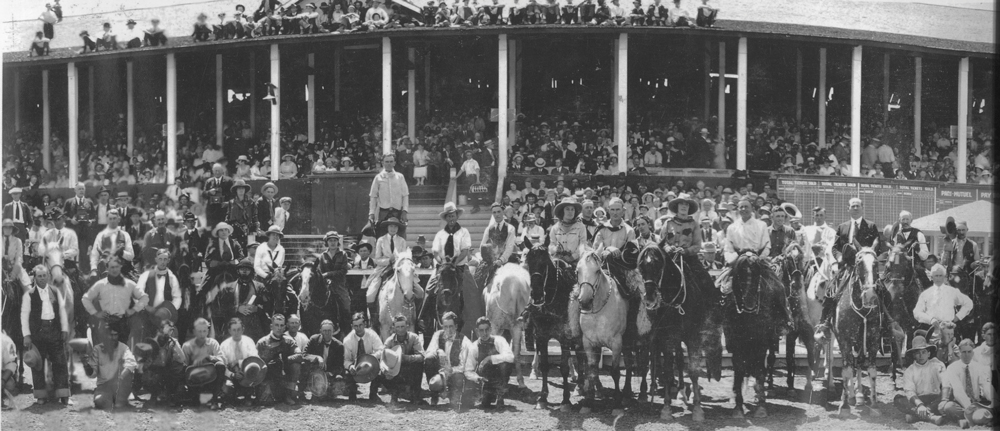
 In spring 1919, the Commercial Club of Reno—a precursor to the Reno Chamber of Commerce—created a committee known as the Reno Rodeo Association. The committee was filled with many of the city’s leading citizens, including cattle baron William H. Moffat, auto dealer John C. Durham, bankers George Wingfield and Charles Mapes, and theater owner Glenn Hurst.
In spring 1919, the Commercial Club of Reno—a precursor to the Reno Chamber of Commerce—created a committee known as the Reno Rodeo Association. The committee was filled with many of the city’s leading citizens, including cattle baron William H. Moffat, auto dealer John C. Durham, bankers George Wingfield and Charles Mapes, and theater owner Glenn Hurst.
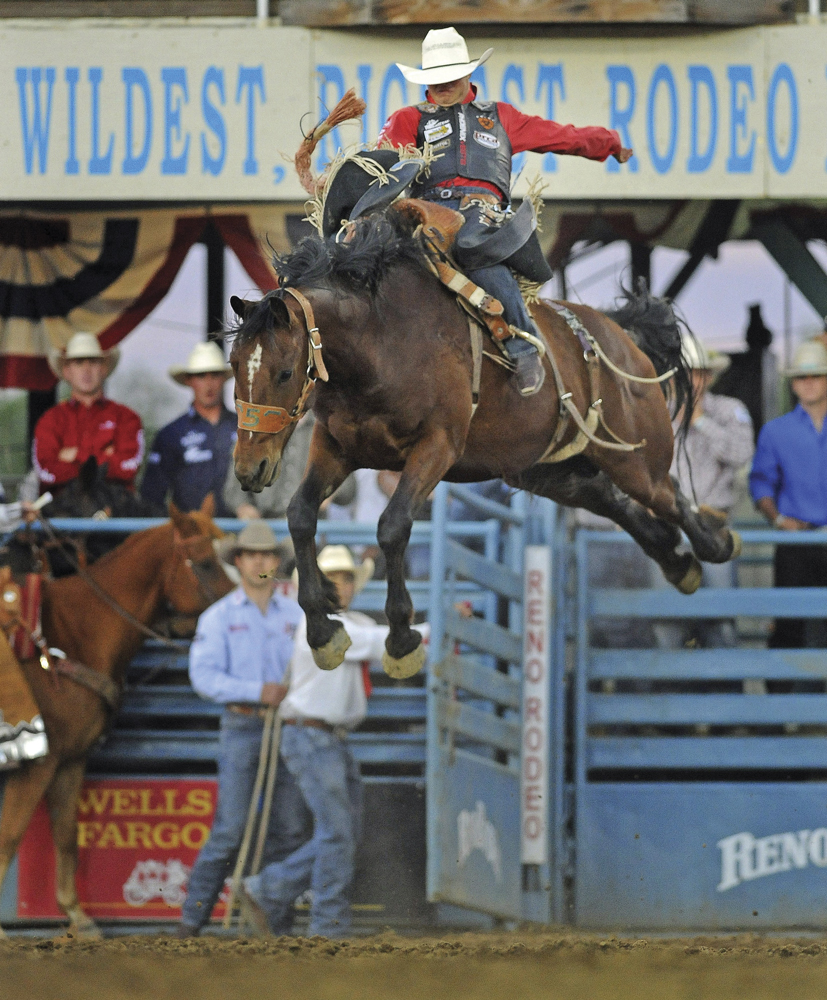
They were charged with a singular task: to create a Fourth of July rodeo so grand that it would attract the top cowboys and cowgirls to compete and visitors from around the country to enjoy. Community members were asked to volunteer for what was called the Nevada Round-Up: Reno’s Annual Carnival of the Range.
One hundred years later, the Reno Rodeo continues to follow that same model: a volunteer army of local citizens create an event that attracts the best riders, ropers, bulldoggers, and entertainers from the world of professional rodeo and put on what is now known as The Wildest, Richest Rodeo in the West.

“All the interest from around the country has been overwhelming,” Mike Torvinen, 2019 Reno Rodeo Association president, says. “I’ve done interviews with the Wrangler Network and other national organizations have reached out. The significance of being around for 100 years and the history of the event; it’s really special to be a part of it.”
The Reno Rodeo is the city’s longest-running special event. This year’s rodeo, which is set for June 20-29, is being celebrated as the 100th anniversary Reno Rodeo instead of the 100th annual because there were years in the 1920s—and one year during World War II—in which no rodeo was held.
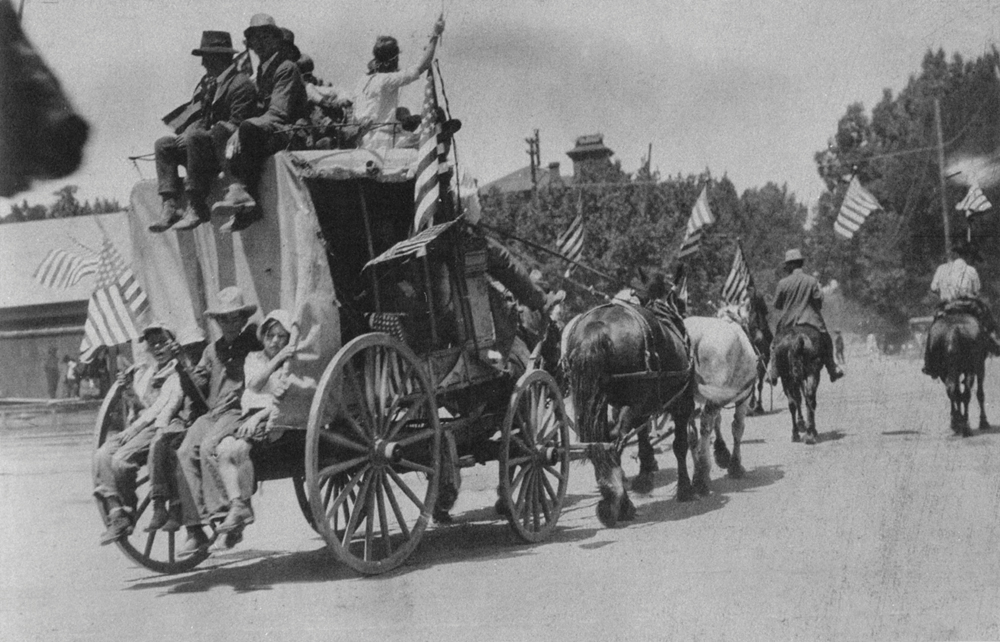
THE BEGINNING
The timing couldn’t have been better for Reno to host a big special event in summer 1919. The country was just out of The Great War, the boys returned home from Europe, and a sense of normalcy was settling in for the country.
Reno filled to capacity as throngs not seen since the Johnson-Jeffries heavyweight title fight of 1910 brought the attention of the world. The hotels were filled, tents set up in vacant lots, and a call was made to homeowners to make any spare rooms available for rent.
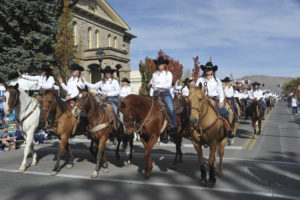
A carnival erected to coincide with the rodeo and provide nighttime entertainment for the masses was named Stingaree Gulch—after the notorious red-light district in Rawhide—and a former cattle rustler turned cowboy artist named Will James was asked to draw the skyline for the makeshift Western town that made up Stingaree Gulch. James was also hired to create artwork for the cover of the rodeo’s program and paid $50 for his efforts. It was the first commercial sale of artwork for the future distinguished author and artist.
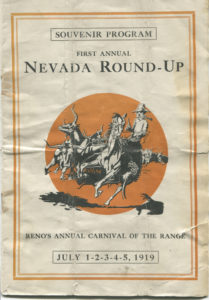 The rodeo itself saw an Alturas cowboy named Hippy Burmister (a former performer in C. B. Irwin’s Wild West Show in Cheyenne) win the coveted bronc riding title. An African-American cowboy, Jesse Stahl, won the steer wrestling event and also put on a popular riding demonstration by mounting a bucking bronc backwards and riding it to the whistle.
The rodeo itself saw an Alturas cowboy named Hippy Burmister (a former performer in C. B. Irwin’s Wild West Show in Cheyenne) win the coveted bronc riding title. An African-American cowboy, Jesse Stahl, won the steer wrestling event and also put on a popular riding demonstration by mounting a bucking bronc backwards and riding it to the whistle.
By every measure—with the exception of the bottom line—the first Nevada Round-Up was a ringing success and prompted the “Reno Evening Gazette” to editorialize:
“For an initial attempt, the rodeo was magnificent entertainment…The rodeo should be made an annual event. It should continue in the hands of volunteer citizens who have started the ball rolling so auspiciously.”
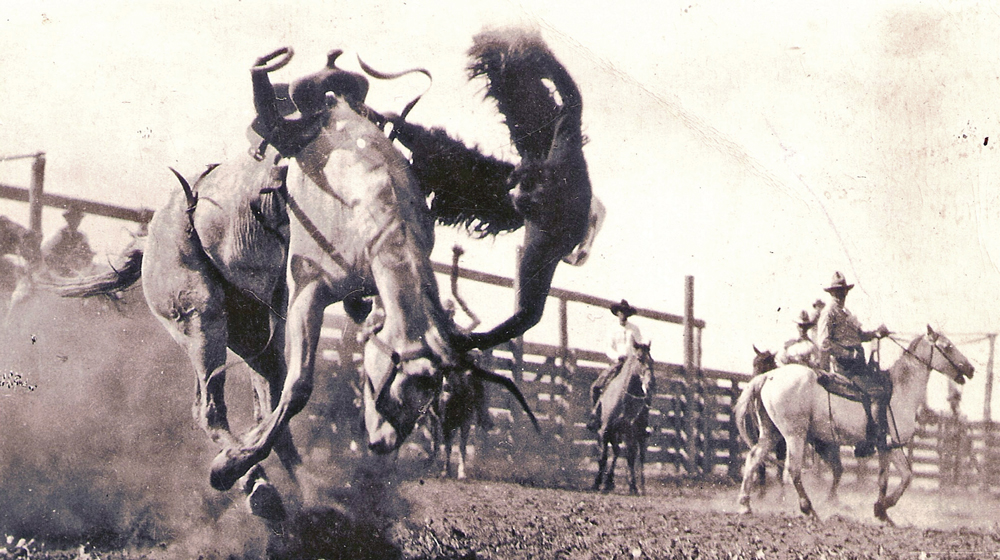
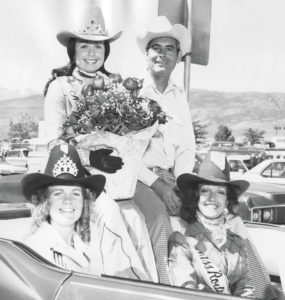
A PRESIDENTIAL MISCALCULATION
Organizers rode the inaugural Nevada Round-Up to successful events in 1920 and 1921 and brainstormed an idea in 1922 to bring even more national attention to Reno and the rodeo. A contest would be held to select “Nevada’s Most Popular Girl,” who would travel to Washington, D.C., and invite President Warren G. Harding to attend the rodeo in Reno.
Mary Harrington, a teacher at Reno’s Southside Elementary School, was the top vote-getter and her trip across country to invite the president and present him with “a six-gallon hat” was well-publicized. Local newspapers carried a photo of Harrington standing alongside Harding, with U.S. Senator Tasker Oddie of Nevada and his wife.
The trip drew its share of publicity, but Harding, whose wife was seriously ill at the time, declined the invitation. In addition, the costs of the trip (along with other expenses of the 1922 rodeo), bankrupted the Reno Rodeo Association.
From 1923 to 1931, no rodeo was held as debts were paid and other special events were put on in the meantime.
It wasn’t until 1932 that another successful rodeo was held in Reno, this time under the name of Pony Express Days. It was held over the Labor Day weekend as the Fourth of July was reserved for a prize fight between Max Baer and Kingfish Levinsky that was promoted by former heavyweight champion Jack Dempsey, who had settled in Reno the year before.
Dempsey became a supporter of the rodeo that year and the winner of the saddle bronc riding—Canadian Pete Knight—was presented with the Jack Dempsey trophy for winning the event.
In 1935, the Reno Rodeo and Livestock Association was formed with Charles Sadleir—the manager of the Riverside Hotel and a champion for good roads in northern Nevada and the Sierra—named president. This was the start of the Reno Rodeo Association as it is known today and Sadleir, whose named is preserved on a street leading to the Reno Livestock Events Center, is known as the father of the Reno Rodeo.
The event was consistently successful into the 1940s. During World War II, when gas rationing had many competitors and travelers sticking close to home, the rodeo went off with mainly locals competing. In 1944, at the height of the war, the rodeo leaders voted not to hold a rodeo.
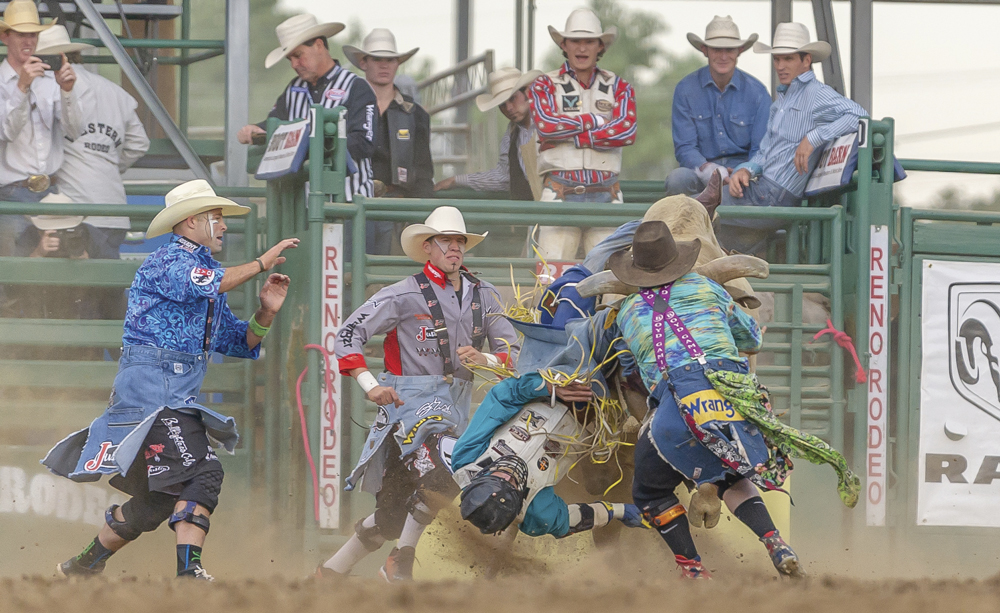
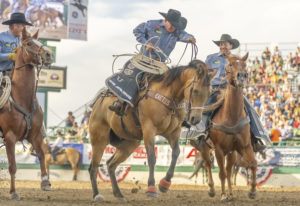
HARRY “BY GOD” FROST
The Reno Rodeo returned in 1945 after a one-year hiatus and has been held every year since—although there was a scare in 1963 in which some rodeo leaders thought about not holding an event.
Not long after the completion of the 1962 Reno Rodeo, the huge wooden grandstand that had been in place for decades burned to the ground in a spectacular fire. Some members of the Reno Rodeo Association were worried new grandstands couldn’t be completed in time and voiced concern that no rodeo should be held at all in 1963. That’s when Harry Frost stood up.
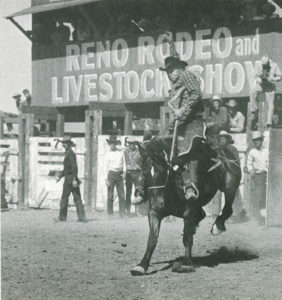
Frost, a tough-as-nails cowboy and former diminutive running back for the University of Nevada football team who owned the Reno Printing Company, was the incoming president for 1963 and he asserted “there would be a rodeo that year, by God, if he had to put it on by himself.” Frost’s assurances rallied the troops and the rodeo was a success.
This was also the year in which the leadership of the Reno Rodeo changed every year with a new president manning the all-volunteer organization.
In the last half-century, the rodeo has held to its roots and to that ideal expressed in the “Reno Evening Gazette” back in 1919: “It should continue in the hands of volunteer citizens who have started the ball rolling so auspiciously.”
“When you look through the history, there were some struggles along the way, and it’s kind of a testament to the people who wouldn’t give up on it,” Torvinen says. “It’s our job now to make sure we’re around for another 100 years.”
100 YEARS OF RODEO FACTS
- Hippy Burmister, the first saddle bronc riding champion at the Reno Rodeo, went on to become the founder of the Rodeo Historical Society, the entity that evolved into the National Cowboy Hall of Fame in Oklahoma City.
- Will James’ first mention in a Reno newspaper was in 1915 when it was announced he’d spent the night in the city jail in Reno before being transported to Nevada State Prison to serve a 12- to 15-month sentence for grand larceny, specifically cattle rustling in White Pine County. In 1919, he was hired to do the artwork for the Reno Rodeo program and by 1920, his art was appearing in national magazines. His most famous book, “Smoky,” was published in 1926.
- Viola Dana, queen of the third Reno Rodeo (then Nevada Round-Up) in 1921 appeared in more than 100 silent movies as an actress and
has a star on the Hollywood Walk of Fame. She was given the keys to the city and had a reception with Gov. Emmett Boyle during the 1921 rodeo. - Charles Sadleir, often referred to as “the Father of the Reno Rodeo” served as the president of the Reno Rodeo and Livestock Association from 1935 until his death in 1948. A street near the rodeo arena was named in his honor in 1941, but the name was misspelled “Sadlier Way” on subsequent street signs and remained wrong for more than 50 years before history buffs, with the support of the Reno Rodeo, had it corrected.
- Former Nevada Governor Morley Griswold served as the arena director at the 1935 Reno Rodeo.
- Cliff Gardner of Washoe Valley was the all-around champion of the Reno Rodeo in 1937. It would take another 79 years before another Nevadan—Elko’s Dakota Eldridge—won the all-around title. Eldridge did it in 2016.
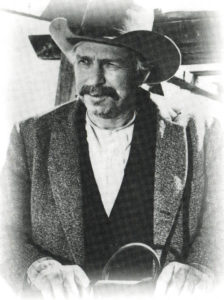
Slim Pickens - Harry Drackert competed in the Reno Rodeo—and other major rodeos around the country—in the 1920s and 1930s and stayed involved with the Reno Rodeo for more than 50 years, serving as the Reno Rodeo president in 1968. He and his wife, Joan, operated dude ranches targeted toward divorcees.
- Western film actor Slim Pickens not only worked as a rodeo clown at the Reno Rodeo in the 1940s, he also competed in the rodeo as a bronc rider.
- Casey Tibbs captured a record nine championships at the Reno Rodeo in the 1950s—five in saddle bronc, one in bull riding, and three in all-around.
- Selena Ulch Pope is the only woman to hold the titles of Miss Reno Rodeo (2003), Miss Rodeo Nevada (2004), and Miss Rodeo America (2005).
- Announcer Bob Tallman, voice of the Reno Rodeo since 1976, signed his first Reno Rodeo contract on a bar napkin. No announcer in history has been selected to work more National Finals Rodeo performances than Tallman. In 2004, he became the first native Nevadan elected to the ProRodeo Hall of Fame.
- Only one cowboy has been killed in competition in the 100-year history of the Reno Rodeo. It happened in the bull riding event in 1947 when rookie rider Bill Brindler, a 24-year-old World War II veteran from Modesto, was bucked off and stepped on by a bull.

Buster Ivory - Buster Ivory won his first Reno Rodeo championship in saddle bronc in 1947 and his second in 1962—a record span of 15 years.
- Actor Sam Elliott was the grand marshal of the Reno Rodeo Parade in 1994 and the final recipient of the Silver Spurs Award, given in Reno to the actor who best portrays the spirt of the West. Elliott was accompanied by his wife, Katharine Ross, who had won the award in 1981.
- Generations of families have been involved with the Reno Rodeo, including: Charles Mapes Sr., one of the founders of the rodeo in 1919 and his son, Charles Jr., who served as president in 1966; Ray Peterson (president 1950-1962) and his son Bob (president 1971); and Jack Walther (president 1964) and his sons Jack (president 1980) and Steve (president 1989).

